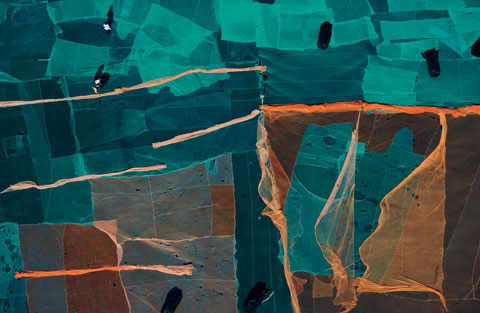Looking Resolutely Downward
When, in 1941, the ill-fated fighter pilot/poet John Gillespie Magee wrote, High Flight, his familiar ode to the joys of flight (“Oh! I have slipped the surly bonds of Earth, And danced the skies on laughter-silvered wings…”), he was clearly on a different page than another celebrated airborne artist who would follow some 50 years later.
Contemporary pilot/photographer Yann Arthus-Bertrand (known as “Yab” to his associates) isn’t concerned with the visceral thrills of aviating. Instead, he looks resolutely downward from helicopters and hot air balloons at every feasible altitude, from a score of dizzying angles to show us the bird’s-eye view of a vibrant mosaic: life on our planet. With deference to Magee, the subject is, indeed, often “surly.” But, seen through the prism of Yab’s extraordinary sensibilities, terra firma seems nonetheless worthy of redemption. That redemption, in fact, became the primary mission of an exuberant personal photographic crusade Arthus-Bertrand launched in 1994. The results coalesced into a collection of stunning imagery, Earth From Above, whose iteration in book form is newly available in a gigantic 10th anniversary edition from Abrams Publishing.
“Gigantic,” incidentally, is not meant to be hyperbole. (Though I do believe there are moments when reviewers of art and photo titles should be paid by the pound). This book’s impressive heft (around 9 lbs) and its 11.5 x 15 x 2-inch dimensions, including gatefolds for text and caption spreads, are consistent with Bertrand’s penchant for grand displays of his aerials—whether on gallery walls or a printed page. As surprising, often gritty, and sometimes purely abstract fine art pieces, these pictures merit lavish treatment. But to Yab and his support team, along with the numerous patrons, public and private, who’ve brought Earth From Above to life; this collection pushes at the boundary between photography and geoscience. It’s far beyond just another anthology of beautiful pictures. It’s an environmental manifesto as well, a treatise on the responsible stewardship of our planet. That message, as Arthus-Bertrand demonstrates, is best articulated with the help of powerful images.
An Alternate Vision of Reality
Yann Arthus-Bertrand didn’t start out to become an environmental activist, let alone a serious photographer. He left a short stint in the motion picture business to manage a French wildlife park, then later found himself participating in a photographic study of lion behavior in Kenya’s Masai Mara National Reserve. While in Africa after being trained as a hot air balloon pilot, he augmented his income by taking tourists aloft to glimpse the spectacle of native wildlife from the air. It was there, hovering above the Kenyan brush that Earth From Above was born in Yab’s imagination. His impulse was not just to shoot the high-altitude sweeping vistas we often associate with dynamic aerials. He was fascinated by that overhead camera position at any distance from a subject. The book’s afterward calls it an “alternate vision of reality which, depending on the distance, reveals objects intimately or encyclopedically.” Originally promoted to potential sponsors as “a general survey on the state of the Earth at the eve of the 21st century,” Earth From Above took years to fund and to force through international bureaucracy and border regulations. In some countries, the editors write, “aerial photography is perceived as being rather like espionage. It took Yann three years to obtain authorization to fly into the airspace of India.”
Words and Images
Eventually the project did sprout wings—rotors, actually—and began its odyssey over 150 countries around the globe. It was soon apparent that an important ecological document was in the making among the thousands of astounding images Arthus-Bertrand and his team had gathered. That role required the support of serious accompanying text. Updated for the 10th anniversary edition, the book is punctuated by essays from a dozen prominent world experts in environmental issues, sustainable development, conservation, biodiversity, climatology, etc. At this size and meticulous reproduction quality, each of the photos in Earth From Above is a story unto itself, begging for detailed caption material to give it depth and traction.
One dramatic image shows Canada’s largest ice breaker, the Louis S. St-Laurent, barely visible among a field of broken pack ice in the Arctic waterway of Resolute Bay. The caption explains, “Sea ice and land ice in the far north have fallen victim to global warming: ice masses [are now] increasingly fragile, setting large icebergs adrift and endangering ships. If melting continues at the current rate, the summer ice pack could disappear by 2020.” A less gloomy chord is struck in the caption for a delicate pattern of drying nets at a Korean seaweed farm: “A genuine ‘sea vegetable,’ [farmed seaweed] is innately suited for sustainable development. It requires unpolluted water and does not destroy its marine environment. The United Nations [now promotes] seaweed farming throughout the world as an efficient means to battle food shortages and poverty.”
One of Earth From Above’s back stories has special resonance. The cover image, “Heart of Voh,” shows a naturally occurring aberration among mangrove growth in the commune of Voh on the South Pacific French territory of New Caledonia. Skeptics aside, the distinctive heart shape is entirely the product of a natural phenomenon. No one intentionally salted the heart shape to prevent mangrove growth on that one section of the swamp. Salt accumulation is the cause for this and similar anomalies.
“Heart of Voh” has become a sort of totem for Arthus-Bertrand’s work, especially this book, whose first edition has already made this image familiar to three million readers, speaking 24 different languages. On the eve of the book’s 10th anniversary, Yab returned to the site in a sort of pilgrimage. In the 12 years since his first photograph, vegetation had already grown significantly back around the margins of the 10-acre site. Tides are gradually reclaiming the heart-shaped salt flat. Presumably, the water level is rising—one of the common harbingers of polar ice melt far to the north and south. “The Voh Heart,” write the editors, “has become emblematic of an Earth we urgently need to better understand.”
Yann Arthus-Bertrand continues to pursue his photographic activism in countless Web-based programs, publications, exhibits and educational endowments. For all this he’s received a Knighthood in the Légion d’Honneur, membership in the French National Order of Merit, and admission alongside Lucien Clergue to the Academy of Fine Arts. And if you wanted to ask him anything lofty about the Earth-bound forces that are changing this planet, the ones he pursues so relentlessly with his camera, he’d no doubt tell you, as he does in Earth From Above, that those forces are straight down beneath his helicopter skids, and they demand our vigilant attention.
Writer/photographer Jim Cornfield is a regular columnist and contributing editor for Rangefinder. He’s based in Malibu Canyon, CA.





